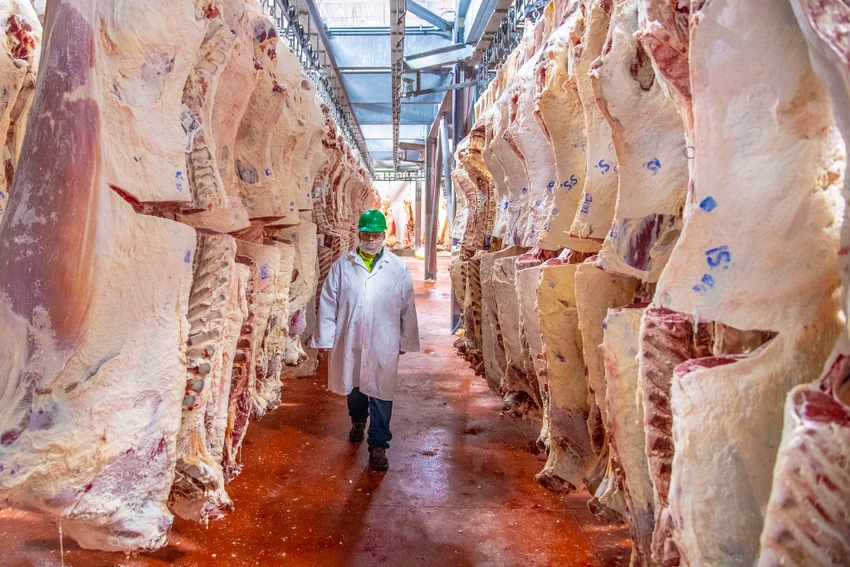It is long past time that the animal protein sector revisits HSPD-9.
December 17, 2020

By Audrey J. Adamson
COVID-19 exposed endemic liabilities in the U.S. animal protein sector. It demonstrated the potential for diseases, zoonotic or not, to derail the entire supply chain; from the farm gate to packing plants; onto grocery shelves; and into restaurant and food service. While we have seen the supply chain slowly recover to recent production levels the industry’s vulnerabilities remain.
The animal protein sector deals with live animals and thousands of human employees. Both have the potential to carry known, new, and emerging pathogens/diseases from farms into packing. Indeed, the World Health Organization (WHO) estimates that 60% of human pathogens are of animal origin; of those 75% can be transmitted to humans. And every year WHO estimates that there are five new emerging diseases. Consequently, we must continue to focus on vectors for transmission of human and or animal pathogens/diseases and a revisit the potential for severe disruption of the animal protein sector supply chain.
Over the past 150 years, Congress, the U.S. Department of Agriculture, states, farmers and ranchers, researchers, universities, and private industry (animal pharma, equipment makers, packing/processing companies, etc.) have been laser focused on preventing, mitigating, and recovering from animal diseases. Without tempting fate, those efforts have largely been successful.
After Sept.11, 2001, the nation refocused our national attention towards aggressively hardening our critical infrastructures. The USA Patriot Act of 2001 and the Homeland Security Act of 2002 designated various sectors of the economy as “critical infrastructures.” In January 2004, the Bush Administration published Homeland Security Presidential Directive/HSPD 9 “Defense of United States Agriculture and Food.” This directive’s purpose was to “…establish a national policy to defend agriculture and food system against terrorist attacks, major disasters, and other emergencies.” HSPD-9 set policy for establishing protection requirements; (1) developing awareness and early warning capabilities; (2) mitigating vulnerabilities at critical production and processing nodes; (3) enhancing screening procedures for domestic and imported products, and (4) enhancing response and recovery procedures.
I remember participating in long and difficult process, aimed at aligning the U.S. government, academia, and U.S. food and agriculture industries. Each sector examined their own liabilities and developed industry-specific approaches towards hardening their industries. The U.S. pork industry did this. I remember some very raw and frank discussions within the pork industry and with the U.S. government. Many protocols were developed, tabletop exercises executed, and communication tools and dark websites produced.
I do not recall focusing on the potential for what happened to the animal protein sector between March-May 2020. Had we prepared for packing plant closures caused by a pandemic disease that spread quickly amongst plant employees, with some very tragic consequences? Had we prepared to respond to a sudden loss of 60% of our marketing outlets as the restaurant and food service sector closed? Had we prepared back on farms and ranches? Unfortunately, none of us had the foresight to prepare for this event.
We saw devastating consequences back on farms and ranches via social media and the nightly news. Americans saw all sorts of American food and agriculture products being plowed under when more Americans than ever were relying on feeding and food programs and grocery shelves often were empty. We saw animals euthanized, milk dumped, and egg sets scuttled. Farm and ranch families were devastated as mental health crises skyrocketed across Rural America.
COVID-19 laid bare the food and agriculture sector weaknesses. While the packing sector did take emergency actions, the animal protein sector was unable to quickly shift production and delivery to meet rapidly changing market conditions.
Reasons are many and varied, but we cannot allow it to happen again. It is long past time that the animal protein sector revisits HSPD-9. It is important that we expand and institutionalize the preventative and emergency actions taken. We know that another pandemic is possible. Perhaps the incoming Biden-Harris Administration should put this at the top of its to-do list for its food and agriculture agenda.
Audrey J. Adamson is the former Vice President for Government Affairs for the National Pork Producers Council. Today, she is the founder and Principal of A2 Strategies, LLC.
You May Also Like


.png?width=300&auto=webp&quality=80&disable=upscale)
